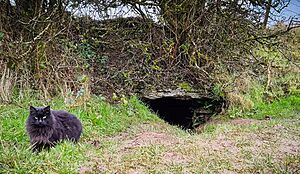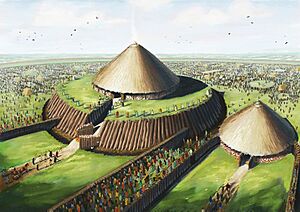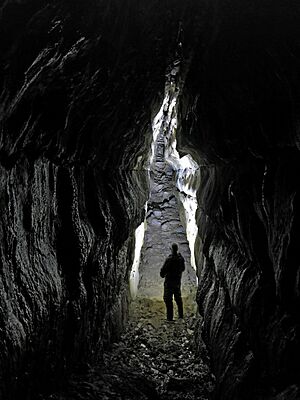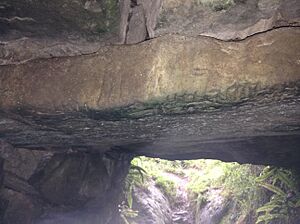Rathcroghan facts for kids
Quick facts for kids
Rathcroghan
Cruachan Aí
Ancient capital of Connacht
|
|
|---|---|
|
Archeological complex
|
|
 |
|
| Website | https://www.rathcroghan.ie/ |
Rathcroghan (Irish: Ráth Cruachan, meaning fort of Cruachan) is a very old and important group of archaeological sites. You can find it near Tulsk in County Roscommon, Ireland. People believe it was once Cruachan, the main capital for the Connachta. These were the ancient rulers of the western part of Ireland. The Rathcroghan Complex (Crúachan Aí) is a special place with many stories found in old Irish books.
Rathcroghan is located on the plains of Connacht (Mag nAí/Machaire Connacht). It is one of the six Royal Sites of Ireland. This area covers about 6 square kilometres (2.3 sq mi) and has over 240 archaeological sites. Sixty of these sites are protected national monuments.
These old sites come from different time periods. They range from the Stone Age (4000–2500 BC) and the Bronze Age (2500–500 BC). They also include sites from the Iron Age (500 BC–400 AD) and the early medieval period. You can find burial mounds, ringforts, and old field boundaries here. Some of the most interesting sites are the Rathcroghan Mound, the mysterious cave of Oweynagat, and the Mucklaghs.
Many old writings mention Rathcroghan (Ráth Crúachan). One important book is the 12th-century Lebor na hUidre. Rathcroghan was known as a place for big fairs in Ireland. It was also one of the island's three main ancient burial grounds. This site is also where a famous Irish story, Táin Bó Cúailnge, begins and ends. It was also the royal home of Medb (Maeve), a powerful warrior queen from Connacht.
People say that Rathcroghan is an entrance to the Otherworld. In medieval times, it was called "Ireland's Gate to Hell." This gate is found through Oweynagat (the Cave of the Cats). The cave is linked to the old festival of Samhain, which is now Halloween. It was also described as the home of Morrígan, a Celtic goddess.
Contents
- Mythical Stories of Rathcroghan
- Rathcroghan's History
- Exploring Rathcroghan's Archaeology
- Main Sites to Discover
- Rathcroghan Mound: The Heart of the Complex
- Rathmore: The Big Fort
- Rath na dTarbh: The Fort of the Bulls
- Reilig na Rí: Burial Place of Kings
- Oweynagat: The Cave of the Cats
- Dathí's Mound: A King's Burial Place?
- The Mucklaghs: Giant Boar's Work?
- Rathbeg: The Small Fort
- Cashelmanannan: Manannan's Stone Fort
- See also
Mythical Stories of Rathcroghan
How Rathcroghan Got Its Name
An old poem called Dindshenchas tells us that Cruachan was named after Crochen. She was a helper to Étaín, a fairy maiden who was reborn as a human. When Étaín went back to the Otherworld with her fairy lover Midir, Crochen went with them. On their way, they stayed in a mound called Síd Sinche.
Crochen loved this síd (fairy mound) so much. She asked Midir if it was his palace. Because she was so loyal to Étaín and respected the place, Midir gave it to her. He named it in her honor. The poem also says that Crochen was the mother of Queen Medb.
The same poem also mentions that Cruachan was a royal cemetery. It says, "Listen, ye warriors about Cruachu! With its barrow for every noble couple." This means it was a burial place for important people.
Rathcroghan in the Ulster Cycle
Cruachan is a very important place in the Ulster Cycle stories. It was the home of Queen Medb, one of the main characters. Her father, Eochaid Feidlech, gave her the kingdom of Connacht. He had removed the previous king, Tindi Mac Conra, because of his bad actions. It's not clear if Tindi ruled from Cruachan or if Medb built it herself.
Another story says that Medb's sister, Clothru, ruled Cruachan before Medb had her killed. Old stories like Fled Bricrenn ("Bricriu's Feast") and Táin Bó Fraích describe the royal home in detail. One description says:
- "The house was made of pine and covered with shingles. It had sixteen windows, each with a brass frame. There were brass beams in Ailill and Medb's room, decorated with bronze. Two silver rails were around it, covered in gold. A silver wand reached the middle of the roof. The house was surrounded from one door to the other."
Cruachan appears at the start and end of the Táin Bó Cúailgne. The story begins with a conversation in the royal home. It ends with a fight between two bulls, which supposedly happened at Rath na dTarbh. This is one of the largest ring-forts at the site.
Samhain and the Otherworld
Cruachan is strongly linked to the festival of Samhain. This is when ancient Irish people believed that old graves opened. Their gods and spirits, who lived inside, would walk the earth. The creatures coming out of Oweynagat were part of this belief.
One legend is "The Adventures of Nera." In this story, a warrior named Nera is dared to tie a twig around a condemned man's ankle on Samhain night. He gets water for the man and finds strange houses. When he returns, he sees Rathcroghan's royal buildings being destroyed by spirits. He follows the fairy group into a síd. There, a woman tells him that what he saw will happen in a year unless his friends are warned. He leaves and tells Ailill mac Máta, who then has the fairy dwelling destroyed.
The Mysterious Oweynagat Cave
It's not clear if the síd mentioned in the story is Oweynagat or the Rathcroghan mound itself.
Inside the cave, on a stone above the entrance, there is an old writing called ogham. Some words that have been translated are "FRAECH" and "SON OF MEDB." It's not known if this is the same Fraech connected to Queen Medb.
An 18th-century story tells of a woman who followed a runaway cow into the cave. She came out miles away in Keshcorran, County Sligo.
Many scary creatures were said to come out of Oweynagat in old tales:
- The name Oweynagat might come from the magical wildcats in "Bricriu's Feast." These cats came from the cave to attack three warriors before Cúchulainn tamed them.
- The Ellen Trechen was a monster with three heads. It caused chaos across the country until Amergin killed it.
- Small red birds came from the cave. They made every plant they breathed on wither. The Red Branch warriors hunted them.
- Herds of pigs with similar powers came out of the cave. Even Ailill and Medb tried to hunt them. But the pigs could vanish and shed their skin to escape.
The Goddess Morrígan
The Morrígan, a powerful goddess, is said to come out of this cave. In the Táin Bó Regamna, she appears on a chariot pulled by a one-legged horse. She brings a cow to breed with the famous Brown Bull. In another story, the Morrígan takes a woman's cows. The woman, named Odras, follows her into the cave. Odras falls into an enchanted sleep. When she wakes, the Morrígan whispers a spell, turning Odras into a river.
Rathcroghan's History
Like other royal sites, there isn't much historical proof or archaeological evidence that Rathcroghan was a royal home or fortress. Many of the best ring-forts in the area are from Christian times. However, it was definitely an important cemetery. Many ring barrows support the old writings that mention it. They list it alongside Tailtiu and Tara as one of the three great burial sites. It was also a gathering place called an oenach.
All these gatherings and oenachs were part of religious and burial traditions. Just as an assembly was held at Tailtiu's cemetery, one would have been held at Cruachan. Many believe that Queen Medb was actually a local earth goddess. Becoming king meant marrying the earth, becoming one with Cruachan. The king's inauguration likely happened on Rathcroghan mound itself.
Rathcroghan's religious importance lessened after Christianity arrived. This is shown in an old book called the Martyrology of Oengus. It compares the end of Cruachan's power with the rise of Clonmacnoise.
New writers didn't really record what happened at these sites. Instead, they created stories where the síd of Cruachan was attacked by Ailill and Medb. They also called Owenagat "hell's gate of Ireland." Around the end of the first century, several raths (forts) were built here. Some of these later included underground passages called souterrains. One entrance to a souterrain was built over Oweynagat. It used standing Ogham stones from the site.
The area is full of old medieval field banks. The best examples are around Reilig na Ri. This shows that Cruachan became important grazing land. It might have been connected to the early medieval fort built at nearby Tulsk. Another nearby site, Carnfree mound, was used to crown the O'Conor kings of Connacht.
There are signs of small groups of houses, or sean bhaile, between the monuments. People might have lived in them long after the Middle Ages. Later, in the mid-1700s, people started surveying the area. Gabriel Beranger made a colorful drawing of Cruachan mound. This work continued in the 1830s with the ordnance survey. With local help, they gave names to the monuments that are still used today.
Not much digging has been done around Rathcroghan mound. But new technologies like radar and magnetic surveys have found features. These show that Rathcroghan is very similar to Tara and Emain Macha. In 1999, the Cruachan Ai visitor center opened in Tulsk. It shares all the latest research on Rathcroghan, Carnfree, and Tulsk.
An old book called the Triads of Ireland (from the 14th to 19th century) mentions the cave. It lists "Úam Chnogba, Úam Slángæ and Dearc Fearna" as "the three darkest places in Ireland." The last one, 'Cave of the Alders', is thought to be Dunmore Cave. The first two mean the caves of Knowth and the caves of Slaney. Some sources say these locations are Rath Croghan, the cave of Slane, and the "Cave of the Ferns."
Exploring Rathcroghan's Archaeology
The Rathcroghan area has over 240 archaeological sites. Sixty of these are national monuments. They are spread out over about 4 square miles (10 km2). These sites date from the Stone Age to the Medieval period. They include burial mounds, ringforts, long earthworks, and enclosed areas.
Main Sites to Discover
Rathcroghan Mound: The Heart of the Complex
Rathcroghan mound is the main point of the complex. It is a wide, flat-topped circular mound. It measures about 89 metres (292 ft) across at the bottom and is 5.5 m (18 ft) high. Gentle slopes on the east and west lead to the top. There are signs of a small mound on the summit.
Surveys have shown that Rathcroghan mound was built on top of an older monument. This older monument had two stone rings. A huge enclosure, about 360 m (1,180 ft) wide and 5 m (16 ft) deep, was also found. This enclosure surrounds the great mound and other monuments. This makes it similar to other royal sites in Ireland, like Tara and Emain Macha.
Rathmore: The Big Fort
The name Rathmore means "Big Fort." This mound is rounded and measures 40 m (130 ft) across. It is surrounded by a ditch that is 7 m (23 ft) wide. This grassy, steep-sided mound might be from the late Iron Age or early Medieval period. Even though it looks like a ringfort, the top is considered too small.
Possible holes found at the top suggest it might have been an Iron Age communal hall. Surveys show signs of hearths, pits, and ovens inside. This fits with the idea that people lived there.
Rath na dTarbh: The Fort of the Bulls
Rath na dTarbh means 'Fort of the bulls'. It is west of Rathcroghan mound. This is a large circular ring fort with a big bank and an outer ditch. There are several breaks in the bank. One on the northeast side might have been an entrance. This is traditionally where the famous bulls, Donn Cuailnge and Finnbennach, fought at the end of the Táin Bó Cúailnge story.
Reilig na Rí: Burial Place of Kings
Reilig na Rí means 'burial place of the Kings'. This is a large circular enclosed area. It is 100 m (330 ft) wide and has a stone and earth bank 1 m (3 ft 3 in) high. Inside, there are signs of a smaller circular enclosure, about 48 m (157 ft) wide.
Old field boundaries cross this site, dividing it into four parts. The remains of five rectangular houses can be seen in and around the site. In 1872, an underground passage (souterrain) was dug up in the southwest part. Animal bones were found there.
Oweynagat: The Cave of the Cats
The Irish name for this site is Uaimh na gCat, which means 'Cave of the Cats'. This is a natural narrow limestone cave. It has a man-made souterrain (underground passage) at its entrance. The original entrance was inside an earth mound. This mound was disturbed when a road was built in the 1930s.
The souterrain is built with dry stone walls and large flat stones. It measures about 10.5 m (34 ft) from the entrance to the natural cave. The natural cave goes on for another 37 m (121 ft).
There is an ogham inscription on a stone above the entrance to the souterrain. It reads 'VRAICCI...MAQI MEDVVI'. This translates to 'of Fraech, son of Medb'. Fraech is linked to Cruachan and Medb in the Táin Bó Cúailnge story. Fraech is also connected to the nearby Carnfree monument. There is a second ogham inscription inside the passage, but it is hard to see and too incomplete to read clearly.
Dathí's Mound: A King's Burial Place?
This mound is believed to be the burial place of Dathí. He was said to be the last pagan High King of Ireland. It looks like a burial mound with banks. It is 40 m (130 ft) wide and has entrances on the east and west. A red sandstone pillar stone stands on top of the mound. The stone is 1.85 m (6 ft 1 in) high.
Studies in 1913 showed that the mound was carved from a natural gravel ridge. Digging in 1981 confirmed this. No graves were found during this dig. However, charcoal samples suggest it was built between 200 BC and 200 AD. This date doesn't match the legend of Dathí's death around 429 AD.
The Mucklaghs: Giant Boar's Work?
Folklore says these huge earthworks were made by a giant boar rooting in the ground. Muic is the Irish word for pig. These are two long earthworks. They have double banks with three ditches. They run northeast and southwest in a curved, parallel line, about 78 m (256 ft) apart.
The Northern Mucklagh is shorter, measuring 100 m (330 ft). But it is very large. The Southern Mucklagh is much longer, about 280 m (920 ft). We don't know for sure what these earthworks were used for.
Rathbeg: The Small Fort
Rathbeg, meaning "Small Fort," is a Ring Barrow. It has clear rings that go around the mound in a tiered way. The mound is about 600 m (2,000 ft) northwest of Rathcroghan mound. It has a double ditch on three sides and an extra ditch on the west side. There is a small pile of stones (cairn) at the top. It is surrounded by small banks and ditches, which create the terraced look. The mound is about 36 m (118 ft) wide.
Tools made of flint found on the mound date from the Iron Age and possibly the Bronze Age. However, the structure itself looks like monuments from the Stone Age.
Cashelmanannan: Manannan's Stone Fort
The Irish name is Caiseal Mhanannán, meaning Manannan’s Fort. This refers to Manannán mac Lir, a god from Irish mythology. These are the remains of an oval stone fort with three closely spaced banks of earth and stone. Each bank is about 1.5 m (4 ft 11 in) wide. The inside is 40 m (130 ft) wide. The outside measures 57 m (187 ft) north/south and 63 m (207 ft) east/west.
Two rectangular enclosures are attached to the main fort on the north and east sides. Each has a single bank. We don't know the exact use of Cashelmanannan because no digging has happened there. But it's the only stone structure in the complex. This suggests it was a high-status building with good defenses.
See also
 In Spanish: Rathcroghan para niños
In Spanish: Rathcroghan para niños







